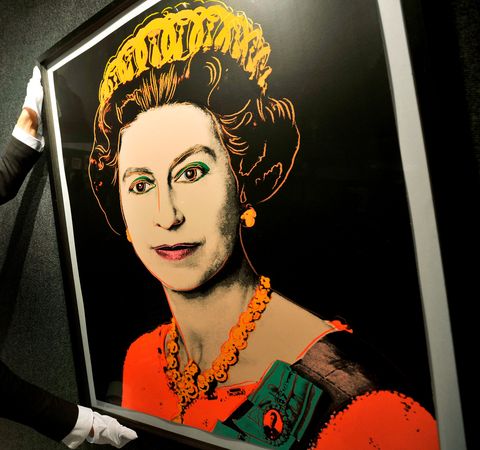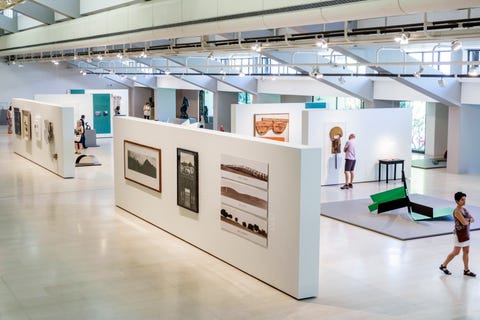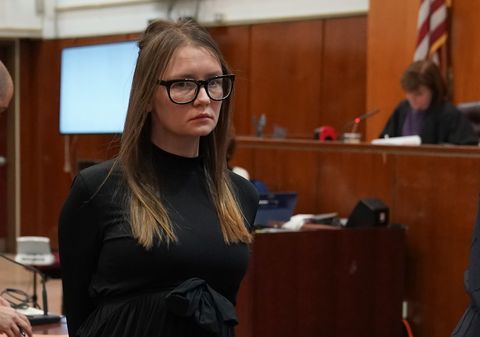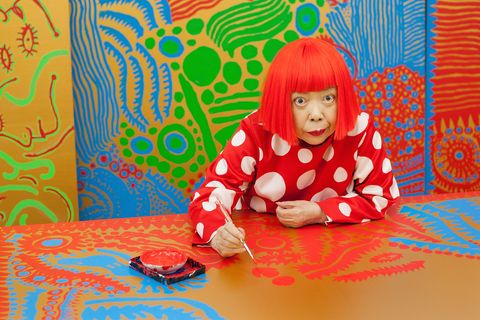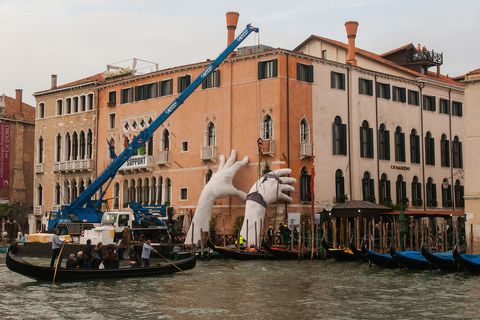Art
Inside the Art Scandal that Rocked European Society – TownandCountrymag.com
Angela Gulbenkian was on a tear. In the summer of 2017 the German-born art adviser spent $10,500 to charter a private jet; $3,920 at the Hotel Café Royal, in London’s Soho neighborhood; $16,985 at Harrods; and $2,610 at Agent Provocateur. She also made stops at Rolex, Gucci, and Christian Louboutin. Her spending wasn’t especially lavish by the standards of the circles she claimed to move in, but there was a problem: The money may not have been hers.
In a bizarre swindle that would wind through Europe and Asia and involve some of the most celebrated names in contemporary art, the Hong Kong–based art dealer Mathieu Ticolat claims that Gulbenkian duped him out of $1.4 million, and that the fortune she was spending was stolen.
In March 2017 Ticolat, who specializes in finding modern and contemporary art for collectors all over the world, was advising a client when another dealer suggested he speak with Gulbenkian. Ticolat was familiar with the family name—the Gulbenkians founded an eponymous museum in Lisbon and have been a fixture in European society for generations—but Angela was a stranger to him. Nevertheless, “a lot of people in the art world knew of her,” Ticolat says, “and never told me of any bad experiences.”
The two were introduced via WhatsApp. Ticolat was looking for art to buy, and Gulbenkian claimed to know of a sculpture for sale. The piece, a work by the Japanese artist Yayoi Kusama (who has been the subject of retrospectives at the Museum of Modern Art and the Tate Modern), was a hot commodity.
This particular sculpture was Yellow Pumpkin, from 2012. It was made of fiberglass and reinforced plastic, weighed 178 pounds, and, Gulbenkian explained, had been kept in a crate in a warehouse in Switzerland since being created. Was Ticolat interested? “It was attractive to buy a large yellow pumpkin at this price,” Ticolat says. “She had access to the work, which I verified, so I went for it.”
Gulbenkian was born Angela Maria Ischwang in Munich on February 17, 1982. As an adult she moved to London, where she married sports agent Duarte Gulbenkian, a great-grandnephew of Calouste Gulbenkian, the late British-Armenian multimillionaire who made a fortune selling oil concessions in the Ottoman Empire to European countries. He was also a prodigious art collector, amassing 6,000 works, most of which now belong to a foundation that bears his name in Lisbon.
Angela Gulbenkian was well spoken and beautiful, and she appeared to move easily among the one percent. She presented herself as an heir to one of the world’s great fortunes; Gulbenkian, the Times of London once wrote, “is one of the best-known philanthropic names, up there with Rothschild, Getty, and Tate.” It was this name that Angela began using when she entered the art business, in February 2016, launching a consultancy called FAPS-Net Limited.
According to a self-written entry on Medium, an online publishing platform, Gulbenkian is “one of the most well-known art collectors and entrepreneurs,” and though today she is only 38 years old, she has been “active in the arts and cultural space for the past 20 years.” According to this bio she facilitated thousands of shipments of art in “a transparent, ethical, and efficient manner.” It was a background people found easy to believe.
When the collector Marie Moatti met Gulbenkian at the Saatchi Gallery in London during an opening for artist Philip Colbert, she says, “we became friendly instantly.” Because Gulbenkian was standing with the famed auctioneer Simon de Pury, “she was sort of validated,” Moatti recalls. Moatti had visited the Gulbenkian Foundation in Lisbon and immediately recognized the name. “Because I knew the foundation, I just felt I could trust her.”
Others weren’t so sure. Indeed, many art world insiders claim never to have heard of Gulbenkian before the scandal. “I don’t think she was very active in the art market,” says Kenny Schachter, a collector as well as a friend and victim of art dealer Inigo Philbrick, who was recently indicted on charges of wire fraud and identity theft. “It would be hard to find people who had dealings with her. She was more of an upstart.” The London-based art critic and filmmaker Ben Lewis agrees, calling Gulbenkian a “hanger-on…trying to make a buck.”
Today the Gulbenkian Foundation is quick to distance itself. “Angela Gulbenkian does not have any relation whatsoever with the foundation and, as far as we know, is married to a Gulbenkian family member who is not a direct descendant of our founder,” a spokesperson told Bloomberg. Neither Gulbenkian, her lawyers, nor her husband responded to Town & Country’s requests for comment.
In April 2017 Ticolat and Gulbenkian settled on the sum of $1,375,000 for the pumpkin and signed a bill of sale. Soon Ticolat wired $100,000 to Gulbenkian’s HSBC account. He didn’t send the payment to an escrow account—which was not unusual, given the old-fashioned agreements the art world still relies on. Ticolat told me this choice was due to “the strong referral from a trusted friend, the need to act quickly, and the Gulbenkian Foundation’s reputation.”
On May 9 Ticolat wired the balance, $1,275,000. He expected the pumpkin to arrive in Hong Kong shortly and told his client as much. Ticolat asked Gulbenkian to restore minor scratches on the pumpkin before shipping it to Asia. “The conservator got paid, the report was done, and it was all good to go,” Ticolat says. But there were delays; issues arose with insurance, customs, and the building of the crate.
While Ticolat waited for the pumpkin, Gulbenkian traveled to Lugano, Sardinia, Lisbon, Venice, Ibiza, and the Greek islands. She also transferred money to her husband and her mother in Munich. Meanwhile, Ticolat grew increasingly distressed. On August 21 he texted, “The pumpkin belongs to me. I paid for it. I want access. I will not wait another day.” Six days later he texted again. “This is insane. This ridiculous situation has been dragging on for months. You are totally irresponsible.” Gulbenkian replied, “If you bother me, I am going to not correspond with you anymore.”
In October 2017 Ticolat flew to London for the Frieze Art Fair, and Gulbenkian suggested they meet at a restaurant in Belgravia. “She spoke very convincingly, sure of herself and what she was doing.” When Ticolat confronted her regarding the delay, Gulbenkian assured him that the work would be released the following week. She explained that the owner of the pumpkin, the head of Porsche, was a “family friend” and “very difficult.” He worried, she said, that the sculpture being sold to another dealer would reflect badly on him, as if he were reselling for a quick profit. Ticolat assured Gulbenkian this was not the case, and they agreed to sign a no-resale agreement. Ticolat flew back to Hong Kong feeling more assured, but when another week passed, he grew angry again. Their mutual animosity was reflected in the messages they began sending each other. “You are a liar,” Ticolat texted on December 14. “Fuck you,” came the reply.
Around then, a friend recommended that Ticolat speak to Chris Marinello, an artist turned lawyer, who founded Art Recovery International in 2013 and has since been dubbed “the Sherlock Holmes of Nazi-looted art.” Around Christmas, Ticolat briefed Marinello on what had transpired. “I haven’t met you,” Marinello told Ticolat. “But I am telling you, this is fraud.” Ticolat denied this assertion, but Marinello was adamant. “You don’t treat a customer that pays $1 million for a sculpture like garbage.”
On January 30, 2018, Marinello, acting on behalf of Ticolat, filed criminal complaints in the United Kingdom and Hong Kong. That June, Marinello heard from the attorney for Art Seen, the agent for the owner of the pumpkin. The pumpkin hadn’t belonged to the head of Porsche. Art Seen’s lawyer informed Marinello that when Gulbenkian failed to deliver the balance owed, they canceled the contract and sold the pumpkin to an anonymous buyer.
It was only then that Ticolat realized he’d been had. “I knew I had been scammed,” he says, and with the pumpkin gone his plan changed. The goal now was to do everything possible to “recoup the money,” Marinello says.
Fraud is not unusual in the $64 billion global art market. In 2020 Philbrick was charged with wire fraud and identity theft after bilking collectors and lenders out of nearly $20 million, and the FBI raided the Michigan property of painter Donald Henkel, who is suspected of running a forgery operation over a period of years. In 2018 a woman going by the name Anna Delvey made headlines for a scam that took in almost $200,000, money that was supposedly meant to build a Manhattan arts club. “Everyone has seen crazy prices, and criminals want a piece of that,” Marinello says. “There are more Philbricks, more Gulbenkians, more Delveys, holding themselves out as someone they are not.”
When Marinello contacted the Metropolitan Police in London, he was met with indifference, he tells me. “We have very few resources available to research art crimes,” Marinello recalls an officer telling him. On June 22, 2018, Marinello and Ticolat filed a criminal suit in the UK, and soon after that they filed a civil suit in Germany to recover $288,000 that Gulbenkian had wired to her mother. On July 27, 2018, a British judge froze what little remained of Gulbenkian’s assets (Marinello says, “It is believed that she is hiding her true assets”) and directed her to pay Ticolat back in full, plus legal fees and attendant court costs. Favorable judgment notwithstanding, Ticolat was still a man who was a pumpkin short and bereft of a million dollars.
Soon Marinello was getting calls from other victims looking for information. There was ArtCube, an online matchmaking service for sellers and buyers in the art world, which told Marinello it had been defrauded of $15,000. Gulbenkian’s former masseuse claimed she had entrusted $65,000 to Gulbenkian, money she has not seen again. An art dealer in New York and an interior design firm in London both claimed to have never been paid for work at her Battersea flat.
“Angela Gulbenkian was obsessed with the pumpkin sculpture by Kusama,” says Jane Morris of the Percy Bass interior design company. “She even had special wallpaper designed with large pink dots inspired by the pumpkin.” The company normally asks for a deposit before commencing work, but Gulbenkian explained that funds were coming directly from Lisbon and urged them to begin. “She pretended that the Gulbenkian Foundation in Portugal paid all her bills,” Morris says.
In February 2019 James Ashcroft, a London art dealer, was approached about buying Andy Warhol’s Queen Elizabeth II. The referral came from a friend who knew a seller named Florian Kappe and his associate, Angela Gulbenkian. By then the Gulbenkian name had been publicly associated with fraud, and Ashcroft was wary. “I am not dealing with that woman,” he told the friend, but he nevertheless agreed to look at the painting. Ashcroft examined it and liked what he saw. “It’s just the sort of picture I like to buy,” he says. “You can sell those every day.”
Ashcroft’s concerns were further assuaged by the fact that Kappe and Gulbenkian had a signed agreement stating that they were acting on behalf of the painting’s owner, the Frankfurt-based businessman Thomas Braun. In March 2019 Ashcroft agreed to wire $150,000 to Gulbenkian’s HSBC account. Just a few weeks after the sale, Ashcroft sold the painting for a profit.
Soon afterward, he received a letter from Braun informing him that Braun had never authorized the sale. Braun pursued Ashcroft in London court, and in March 2020 Ashcroft agreed to pay him back for the picture plus legal fees. Kappe has argued that the painting was meant for “viewing purposes only” and should not have been released to Ashcroft. In the following months Gulbenkian posted photos on Instagram from Art Basel, the Venice Biennale, and other locations around the world, posing with the likes of Ai Wei Wei, but in reality she was wading deeper into the legal morass. On April 13, 2019, a warrant was issued in the UK for Gulbenkian’s arrest, but she had already fled to her mother’s house in Germany.
When Marinello found out, he asked the German authorities to arrest her, but they were unable to, as there was not yet an extradition treaty in place between Germany and the UK. Eventually, a court hearing was set for May 14, 2020, in Britain. After a series of delays, Gulbenkian failed to appear at a second hearing, and a warrant was issued for her arrest.
In the meanwhile, Gulbenkian (whom ArtNet referred to as a “runaway art heiress”) had left Germany for Lisbon, and on June 16 she was arrested by the Portuguese authorities. A hearing in the German case was held in September; a decision is still pending. Gulbenkian was held in a women’s prison in Portugal before being extradited to the UK in December. Her trial is scheduled for early 2021.
“She lied, fabricated email correspondence, and faked bank transfers, but she also made real payment of deposit and restoration, and shipping costs,” Ticolat says. That was, in a way, her genius: What she said always had a basis in reality. She was indeed married to a Gulbenkian, and the business of shipping costly artworks is indeed fraught. Most crucially, perhaps, it turns out she did know something about art and its value. Three years after her million-dollar scam, the Kusama pumpkin Gulbenkian sold to Ticolat for $1.4 million has doubled in price.
This story originally appeared in the February issue of Town & Country.
This content is created and maintained by a third party, and imported onto this page to help users provide their email addresses. You may be able to find more information about this and similar content at piano.io
Art
Art in Bloom returns – CTV News Winnipeg
Art
Crafting the Painterly Art Style in Eternal Strands – IGN First – IGN
Next up in our IGN First coverage of Eternal Strands, we’re diving into the unique and colorful art in the land of the Enclave. We sat down with art director Sebastien Primeau and lead character artist Stephanie Chafe to ask them all about it.
IGN: Let’s talk about Eternal Strands’ distinctive art style. What were some of the guiding principles behind the art direction?
Primeau: I think what was guiding the art direction at the beginning of the project was to find the scale of the game, because we knew that we were having those gigantic 25-meter tall creatures and monsters. So we really wanted to have the architectural elements of the game – the vegetation, the trees – to reflect that kind of size.
So one of my inspirations was coming from an architect called Hugh Ferriss, and I was very impressed by his work, and it was very inspiring for me too. So just the scale of his work. So he was a real influence for Metropolis, Gotham, so I was really inspired by his work.
Chafe: I think one of the things that, just as artists and as creators, we were interested in as well was going for a color palette that can be very bright. And something that can really challenge us too as artists, and going into a bit more of at-hand painterly work, and getting our hands really into it, into the clay, so to speak, and trying to go for something bright and colorful.
IGN: That’s not the first time I’ve heard your team describe the art style as “painterly.” What does that mean?
Primeau: Painterly is just a word that can give so much room to different types of interpretation. I think where we started was Impressionist painters. So I really enjoy looking at many painters, and they have different types of styles. But we wanted to have something that was fresh, colorful, and unique.
And also, I remember when we were starting the project there was that word. “It’s going to be stylized,” but stylized is just a word that gives so much room to different kinds of style. And since we were a small team, we had to figure out a way to create those rough brushstrokes. If it was painted very quickly by an artist, like Bob Ross would say, “Accident is normal.” So I think we wanted to embrace that. And because we’re all artists, it’s hard too, at some point, to disconnect from what you’re doing. It’s like, “Oh, I can maybe add some more details over there.” But I was always the- “Guys, oh, Steph, that’s enough. Let’s stop it right there. I think it looks cool.”
IGN: So, when you create an asset for Eternal Strands, is somebody actually painting something?
Chafe: I can speak more on the character side. For us, we do a lot of that hand painting, a lot of those strokes by hand. And we try to embrace, not the mistakes, but the non-realistic part of it having an extra splotch here and there.
We’ve got brushes that we made that can help us as artists to get the texture we’re looking for. It really is a texture that gives to it. But a lot of the time it’s not just something generated in a substance painter, or getting these things that will layer these things for you, making it quick and procedural. Sometimes we have those as helpers, but more often than not we just go in and paint.
IGN: Eternal Strands is a fair bit more colorful than lots of games today. Why was it important to the team to have lots of bright colors?
Primeau: You need to be careful, actually, with colors. Because with too many colors you can create that kind of pizza of color.
We wanted to balance the color per level, because we’re not making an open-world game. I really wanted each level to have their own color palette identity. So we’re playing a lot with the lighting. The lighting for me is key. It’s very important. You can have gorgeous textures, props, characters, but if your lighting is not that great, it’s like… So lighting is key. And especially with Unreal Five, we have now, access to Lumen. It brought so much richness to the color, how the color is balancing with the entirety of the level. It definitely changed the way we were looking at the game.
We’re using the technology, but in a way to create something that feels like if you were looking at a painting. I think we have achieved that goal.
Chafe: I’m very happy with it.
IGN: What were your inspirations from other games or other media when developing the art style?
Primeau: I have many. I’ll start with graphic novels, European graphic novels. I really wanted to stay away from DC comics, Marvels comics, those kinds of classics.
Before I started Eternal Strand, I saw a video. It was one of the League of Legends short films for a competition. It’s “RISE.” I don’t know if you remember that one, but it was made by Fortiche Studio who did Arcane, and I’m a huge fan of Arcane. When I saw that short film, it was way before Arcane was announced, I was like, “oh gosh, this is freaking cool. This is so amazing. I wish I would be able to work on a game that has that kind of look.”
Chafe: For me, when we started the project, one of the things that I wanted to challenge myself a lot was in concept and drawing and stuff like that and doing more, learning more about color as well, which is something I find super fascinating and also kicks my butt all the time because of just color theory in general.
But with the [character] portraits specifically, I think, I mean, growing up I played a lot of games, a lot of JRPGs too. I played just seeing basic portraits in something like Golden Sun or eventually also Persona and of course Hades, which is a fantastic game. I played way too much of that, early access included. But I really liked that part. Visual novels too, just that kind of thing. You can get an emotion from a 2D image as well when it’s well done, especially if you have voices on top of it.
IGN: Were there any really influential pieces of concept art that served as a guiding document the team would reference later on?
Chafe: I have one personal: It’s really Maxime Desmettre’s stuff because it was so saturated. Blue, blue, blue sky. Maxim Desmettre is our concept artist that we have who works from Korea. When I joined the project, seeing that was just like… and seeing that as a challenge too, like ‘how are we going to get there?’
The one that I’m thinking of that hopefully we could find after, just in general with the work that always speaks so much to me is this blue, blue sky and the saturation of the grass. But also when he gets into his architecture and stuff like that, there’s just a warmth to everything. The warmth to the stone that just makes it look inviting and mysterious at the same time. And I think that really speaks a lot to it.
IGN: How did you go about designing Eternal Strand’s protagonist: Brynn?
Primeau: I think that Mike also, when he pitched me the character, he was using Indiana Jones as an example. So courageous, adventurer guy, cool guy. Also, when you’re looking at Indiana Jones, he’s a cool guy. And we wanted to create that kind of coolness also out of our main protagonist. And I remember it took time. We did many iterations.
Chafe: It was a lot of iterations for sure. Well, I think I had done a bunch of sketches because it’s what’s going to be the face of the player, and also to have her own personality as well in the story, and her history as well. And the mantle was a really big one too. What gives her one of sets of her powers and stuff, figuring that out was actually one of the longest processes. It’s just a cape, but at the same time, it’s getting that to work with gameplay and all that kind of stuff. But yeah, all of Brynn’s personality and her vibe really comes from a lot of good work from the narrative team. So, mostly collaboration there.
IGN: What’s the deal with Brynn’s mentor: Oria? How did you settle on a giant bird?
Chafe: Populating the world of the enclave was, “it’s free real estate.” You get to just throw things on the wall and see what sticks. And, “Oh, that’s really cool. Oh, that’s nice.” At some point I’d done a big sketch of a big bird lady with a claymore, and Seb said, “That’s cool.” And then kind of ran with it.
IGN: What’s the toughest part about the art style you’ve chosen for Eternal Strands?
Primeau: The toughest part was…A lot of people in the team have experience making games, so it was to get outside of that mold that we’ve been to.
For me, working on games that were more realistic in terms of look, I think it was really tough just to think differently, to change our mindset, especially that we knew that we would be a small team, so we had to do the art differently, find recipes, especially when we were talking about textures, for example. So having a good mix.
Chafe: One of the things too is also as we’re all a bunch of artists, and every artist has their own style that they just suddenly have ingrained in them, and that’s what makes us all unique as artists as well. But when you’re on a project, you have to coalesce together. You can’t kind of have one look different from the other. When you’re doing something more realistic, you have your North Star, which is a giant load of references that are real. And you can say “it has to look like that, as close to that as possible.”
When you have a style in mind and you’re developing at the same time, you kind of look at it and you review it and you have a feeling more than anything else.
You’re training each other with your styles as you kind of merge together in the end. And that kind of is how the style happened through, like you mentioned, like finding easy recipes, through just actually creating assets and seeing what comes out and, “Oh, that’s really cool. Okay, we can now use that as kind of our North Star.”
For more on Eternal Strands, check out our preview of the Ark of the Forge boss fight, or read our interview with the founders of Yellow Brick Games on going from AAA studios to their own indie shop, and for everything else stick with IGN.
Art
Collection of First Nations art stolen from Gordon Head home – Times Colonist
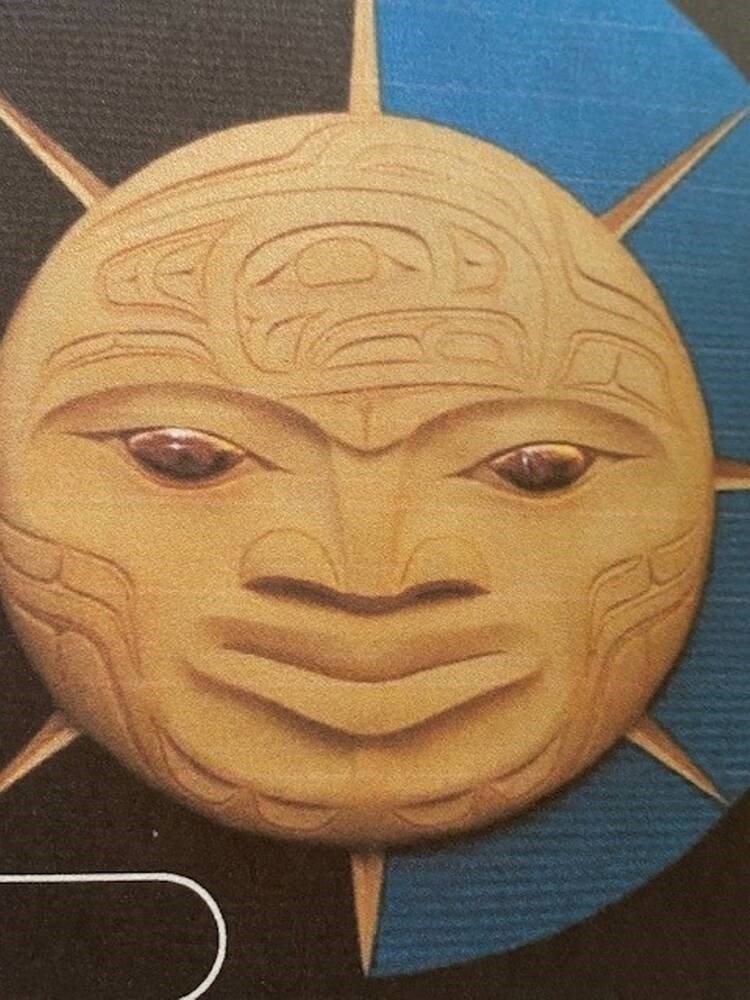

Saanich police are investigating the theft of a large collection of First Nations art valued at more than $60,000 from a Gordon Head home.
The theft happened on April 2.
The collection includes several pieces by Whitehorse-based artist Calvin Morberg, as well as Inuit carvings estimated to be more than 60 years old.
Anyone with information on the thef is asked to call Saanich police at 250-472-4321.
jbell@timescolonist.com
-



 Investment14 hours ago
Investment14 hours agoUK Mulls New Curbs on Outbound Investment Over Security Risks – BNN Bloomberg
-



 Sports12 hours ago
Sports12 hours agoAuston Matthews denied 70th goal as depleted Leafs lose last regular-season game – Toronto Sun
-



 Tech13 hours ago
Tech13 hours agoSave $700 Off This 4K Projector at Amazon While You Still Can – CNET
-



 Tech12 hours ago
Tech12 hours ago'Kingdom Come: Deliverance II' Revealed In Epic New Trailer And It Looks Incredible – Forbes
-



 Science14 hours ago
Science14 hours agoJeremy Hansen – The Canadian Encyclopedia
-
Business11 hours ago
BC short-term rental rules take effect May 1 – CityNews Vancouver
-



 Investment11 hours ago
Investment11 hours agoBenjamin Bergen: Why would anyone invest in Canada now? – National Post
-
Art10 hours ago
Collection of First Nations art stolen from Gordon Head home – Times Colonist



